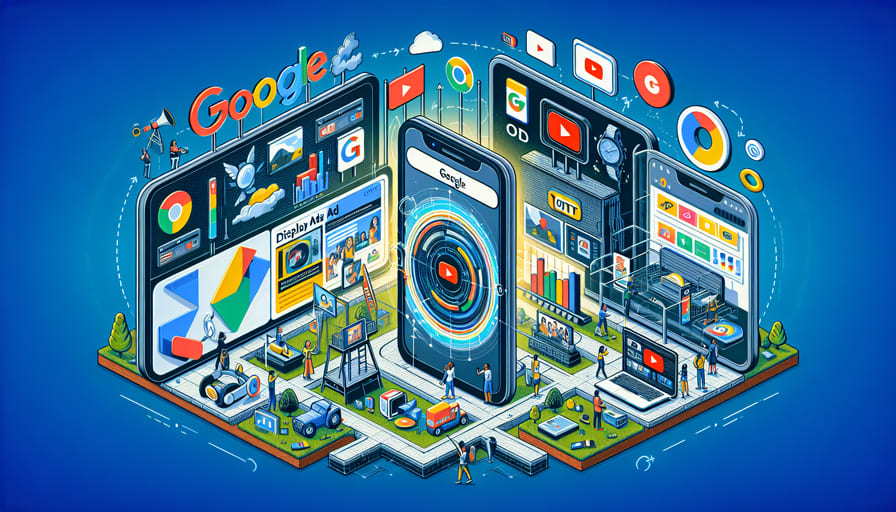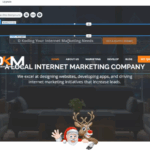Digital display advertising stands at the forefront of this revolution, including the dynamic spheres of display advertising, video advertising, and the burgeoning domain of OTT (over-the-top) advertising. Each advertising method offers unique advantages in reach, audience targeting, formats, and overall ROAS (Return on Ad Spend). Understanding the nuances and capabilities of each can significantly enhance your marketing strategy, ensuring your message resonates with your intended audience and drives the desired action.
This article will delve into the key differences and synergies between Google Display Ads, Google Video Ads, and OTT advertising, providing a comprehensive overview of how these platforms can maximize your marketing impact. We’ll explore the extensive reach and sophisticated targeting options of Google’s advertising platforms, which allow for unparalleled audience engagement across millions of websites and videos. Additionally, we’ll demystify OTT advertising, highlighting its premium content environment and captive audience benefits. Whether your goal is to enhance brand visibility, drive direct responses, or achieve a flexible and cost-effective ad strategy, understanding the interplay between digital display advertising, video, and OTT ads can empower you to make informed decisions and adapt to future trends in the digital advertising space.
Understanding Google Display Ads
Types of Display Ads
Google Display Ads are versatile, appearing across over 3 million websites and 650,000 apps, including high-traffic areas like Gmail and YouTube. These ads range from static images to animated and video ads, ensuring that your message is seen and engages the viewer in various formats.
Benefits of Display Ads
The significant advantage of using Google Display Ads is their extensive reach, which taps into 90% of internet users worldwide. This vast network allows for precise audience targeting through contextual and demographic filters, enhancing the likelihood of reaching consumers most interested in your offerings. Additionally, the integration with Google Analytics aids in measuring ad performance and optimizing strategies for better returns on investment.
Best Practices for Google Display Ads
To maximize the effectiveness of your Google Display Ads, it’s crucial to focus on high-quality asset creation. This includes transparent, compelling images and concise messaging that aligns with your brand voice. Google’s AI optimizes these assets across various platforms, continuously testing and improving to ensure the best performance. Moreover, responsive display ads can significantly increase your ads’ visibility and engagement, adapting seamlessly to different sites and devices.
Adhering to these practices and leveraging Google’s advanced targeting capabilities can enhance your digital marketing efforts and achieve a higher return on investment.
Understanding Google Video Ads
Types of Video Ads
Google Video Ads offer various formats to capture your audience’s attention effectively. You can choose from skippable in-stream ads, which allow viewers to skip the ad after 5 seconds, or non-skippable in-stream advertisements that are typically 15 to 30 seconds long and must be watched before continuing to the video content. In-feed video ads are displayed alongside other YouTube content, inviting users to click and watch your video, while bumper ads, lasting 6 seconds or less, provide a quick message that cannot be skipped. Outstream ads start with the sound off and play on partner sites, and masthead ads appear at the top of the YouTube homepage, auto-playing for maximum visibility.
Benefits of Video Ads
Utilizing Google Video Ads can significantly enhance your reach and engagement. These ads allow you to target specific demographics, interests, and behaviors, ensuring your message reaches the most relevant audience. Video ads are also integrated with Google’s powerful analytics tools, enabling you to track performance and optimize campaigns for better results. The flexibility in ad formats means you can choose the best way to present your message, whether a brief introduction to your brand or a detailed product demonstration.
Best Practices for Google Video Ads
To maximize the impact of your Google Video Ads, it’s crucial to focus on high-quality video production and clear messaging. Ensure your ads engage from the first second and maintain a solid call to action. Utilizing features like auto-play and optimizing your ads for mobile devices can also increase engagement rates. Regularly reviewing and adjusting your targeting options will help you maintain the effectiveness of your campaigns, keeping them cost-effective while achieving the desired impact on your audience.
What is OTT and How Does it Work?
OTT (over-the-top) media services deliver content directly to viewers over the internet, bypassing traditional broadcast and cable television. This method allows users to access streaming services like Netflix and Hulu through various devices, including laptops, smartphones, and smart TVs.
OTT vs. Traditional TV
Unlike traditional TV, which relies on cable connections, OTT provides content through the internet. This shift means that viewers can enjoy a more personalized viewing experience with features like pausing, rewinding, and accessing ad-free content, which are not typically available with standard cable services. Additionally, OTT platforms can offer targeted, on-demand content, contrasting traditional TV’s broad, scheduled programming.
Benefits of OTT Advertising
OTT advertising allows for precise targeting and detailed analytics, providing advertisers with the tools to reach specific demographics and measure campaign effectiveness efficiently. Advertisers can target audiences based on viewing habits, geographic location, etc. Moreover, OTT ads often need to be more skippable, ensuring higher engagement rates than traditional TV ads.
Devices Used for OTT
Various devices support OTT streaming, including connected TVs (CTVs), gaming consoles, and mobile devices. These devices help users access a wide range of streaming services at their convenience, whether at home or on the go. The flexibility in viewing options, coupled with the increasing quality of content, makes OTT a popular choice among consumers, further driving the growth of OTT platforms.
Combining Google Display, Video Ads, and OTT for Maximum Impact
Integrated Advertising Strategies
Integrating Google Display and Video Ads with OTT advertising is crucial to maximizing your marketing impact. By leveraging Google’s extensive reach and sophisticated targeting capabilities alongside OTT’s immersive, premium content environment, you can create a cohesive advertising strategy. This approach enhances brand visibility and drives higher engagement through diverse ad formats and precise audience targeting.
Case Studies and Success Stories
Companies like GEICO have demonstrated the effectiveness of this integrated strategy. In 2020, GEICO invested significantly in OTT advertising, becoming one of the top spenders in this domain, which complemented their other digital advertising efforts and helped them reach new audiences during a critical time. This strategic move showcases how combining different advertising platforms can lead to substantial brand growth and market reach.
Measuring and Analyzing Performance
Advanced analytics and performance metrics can measure the success of combining Google Display, Video Ads, and OTT. Utilizing tools like Google Analytics alongside OTT’s improving measurement capabilities allows for detailed performance tracking. This data-driven approach helps optimize campaigns and improve ROAS by understanding audience behavior and ad effectiveness across platforms. By continuously analyzing these metrics, advertisers can refine their strategies to ensure maximum impact and efficiency in their advertising efforts.
Future Trends in Display, Video Ads, and OTT
Emerging Technologies
Advancements in artificial intelligence (AI) and machine learning (ML) are set to transform the future of OTT advertising. These technologies will enable more sophisticated targeting strategies by analyzing user behavior in real-time to deliver highly personalized ads. Additionally, augmented reality (AR) is expected to revolutionize OTT advertising by creating immersive and interactive ad experiences, blurring the lines between content and advertising. This integration of e-commerce within OTT platforms will facilitate direct purchases from ads, enhancing viewer engagement and driving conversions.
Predicted Changes in Consumer Behavior
As digital media consumption continues to rise, consumers increasingly favor on-demand and streaming services over traditional media channels. This shift is evident as more consumers prefer streaming platforms for their flexibility and personalized content offerings. Businesses must adapt by targeting these digital-savvy audiences, utilizing the data-driven capabilities of OTT platforms to deliver relevant and engaging advertising content.
Adapting Strategies for Future Success
To stay competitive, advertisers must embrace programmatic advertising and evolve to be more privacy-focused and efficient. The decline of third-party cookies prompts a shift towards first-party data and privacy-first marketing strategies, enhancing consumer trust and compliance with privacy laws. Advertisers should also consider diversifying their ad placements across various platforms, including connected TV (CTV), to maximize reach and effectiveness. Integrating these advanced technologies and strategic approaches will be crucial for achieving higher engagement and better ROI in the evolving digital advertising landscape.
Closing Remarks on OTT Advertising
Through this article, we’ve navigated the intricate landscape of digital advertising, comparing and contrasting the realms of Google Display and Video Ads with OTT advertising.
Each platform brings unique benefits – from the extensive reach and sophisticated targeting capabilities of Google Display and Video Ads, which can engage audiences across the vast expanse of the internet, to the premium content environment and captive audience offered by OTT advertising. Such depth of choice allows marketers to tailor their strategies specifically, leveraging the cost-effectiveness and detailed analytics of Google’s platforms for broad reach or tapping into OTT’s immersive advertising experience for enhanced brand visibility.
Choosing between Google Display and Video Ads and OTT advertising hinges on the specific objectives of a campaign. For those valuing broad reach, specific targeting, and budget flexibility, Google’s platforms emerge as the superior choice, facilitating detailed measurement and analytics for data-driven decision-making. On the other hand, OTT advertising stands out for its ability to place brands in the spotlight alongside premium content, offering a traditional TV advertising feel but with the added advantages of digital targeting and engagement. As advertisers look to the future, understanding and adapting to these platforms’ evolving capabilities—programmatic advertising, privacy-first strategies, or integrating emerging technologies—will be crucial in crafting impactful marketing strategies that resonate with and captivate the intended audience.








0 Comments